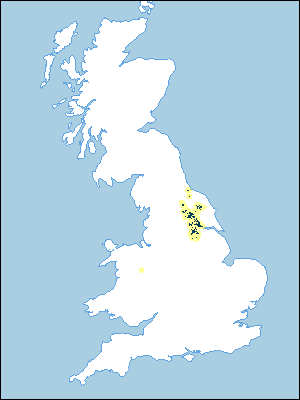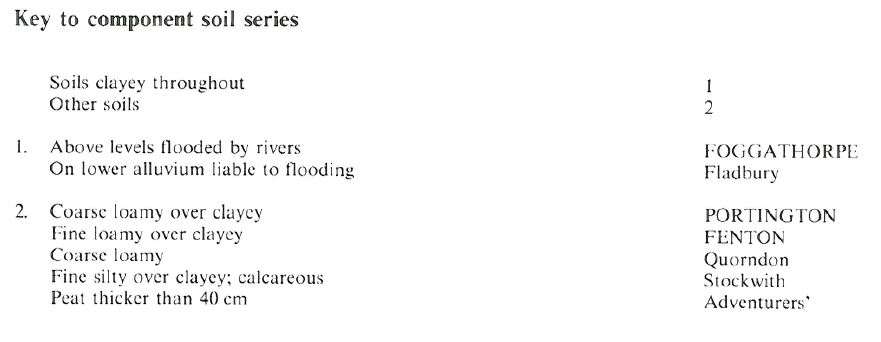
Soil Associations
0712i FOGGATHORPE 2
Soil and site characteristics
Slowly permeable seasonally waterlogged stoneless clayey and fine loamy over clayey soils. Some similar coarse loamy over clayey soils.
Geology
Glaciolacustrine clay
Cropping and Land Use
Cereals and grassland with stock rearing.
Component soil series
| Subgroup | Series name | Percentage | WRB 2006 link |
|---|---|---|---|
| 7.12 | FOGGATHORPE | 65% | Clayic Eutric Stagnosols |
| 7.13 | PORTINGTON | 15% | Ruptic Eutric Planosols |
| 7.13 | FENTON | 10% | Ruptic Albic Mollic Planosols |
Covers 799 km2 in England and Wales
Soilscapes Classification
| 18 |
Slowly permeable seasonally wet slightly acid but base-rich loamy and clayey soils |
0712i FOGGATHORPE 2
Detailed Description
This association is dominated by slowly permeable clayey and fine loamy over clayey stoneless soils on glaciolacustrine clay. It is extensive in Northern England, from Northallerton through the Vale of York to the Doncaster district, and is also widespread in the western half of the Vale of Pickering. Elsewhere, it is found in north Nottinghamshire and near Welshpool, in Wales. The most important soil covering three quarters of the land is the slowly permeable Foggathorpe series. This very strongly mottled soil is often clayey throughout, but locally has a thin fine loamy topsoil. Soils of the Fenton series, with a thicker, fine loamy topsoil are important in places, as is the Portington series, a strongly mottled coarse loamy over clayey soil, found where sandy drift overlies the clay.
The association covers 780 km² but the soil pattern is very simple, large areas being covered solely by the Foggathorpe series, pelo-stagnogley soils. The subsidiary Fenton series, cambic stagnogley soils, is most commonly found in shallow depressions where loamy drift has accumulated. The Portington series, cambic stagnogley soils, and, occasionally, the Quorndon series, occur where glaciofluvial or windblown sand forms slightly elevated areas. On the large expanses of the Foggathorpe association in the Vale of York the Portington soils provide the only suitable building land, so usually farms and villages are sited on them. In places Fladbury soils are associated with river floodplains, and the peaty Adventurers' series is common locally on Pickering Carrs. Near Staddlethorpe, the Stockwith series borders the Humber warplands.
Soil Water Regime
Seasonal wetness is the main feature of the soils. Underdrainage is essential in Foggathorpe and Fenton soils before the land can be brought into arable use. Foggathorpe, Fenton and Portington soils are slowly permeable and can be seasonally waterlogged (Wetness Class III and IV) even with drainage. Relatively, Portington soils have more permeable upper horizons but excess winter rainwater is not readily absorbed. Soil moisture reserves available to plants in summer are not large. As a result, the Foggathorpe and Portington series are slightly droughty for cereals in an average year. For grass, Foggathorpe soils are moderately, and Portington soils very droughty.
Cropping and Land Use
In the past, the clayey soils and surface wetness have restricted cropping to grass, with cereals on the naturally better drained land. Following extensive drainage in recent years however, cereal growing, particularly of winter wheat, has increased at the expense of permanent grassland. Oilseed rape, a very tolerant crop, has also become popular. Potatoes and sugar beet are grown but are difficult to harvest in wet seasons. Sugar beet is grown mainly because sugar is processed nearby at York. This shows that there is more opportunity for landwork in autumn than in spring, but on the Foggathorpe and Fenton series the work period is restricted, particularly in the moister climate around York; in wet years the number of good days for landwork is very restricted. The small areas of the Portington series can be cultivated safely for a slightly longer period. There is less opportunity to work the soils satisfactorily in spring in most years and spring working is impossible in a wet season. Thus autumn-sown crops are generally chosen, leaving the few suitable spring days free for sowing sugar beet and potatoes, when timeliness is critical. Subsoiling in early autumn, when the soil is still relatively dry, helps to reduce wetness by breaking up subsurface compaction. Direct drilling of autumn sown crops avoids some cultivation problems, but good management is needed to achieve yields similar to conventionally sown crops. Direct drilling can be useful on large farms, however, because of the limited number of machinery work days. Grass grows well in spring although the land is easily poached; summer growth in the Vale of York is restricted by drought. Slurry spreading is difficult because of the wetness in winter and spring, when there is severe risk of wheel rutting and pollution of streams by surface run-off. Phosphorus levels can be low, but deficiencies are easily corrected. Acidity is likely where liming has been neglected.
0712i FOGGATHORPE 2
Distribution Map
 |
Note that the yellow shading represents a buffer to highlight the location of very small areas of the association.
Keys to component soil series
Northern Region
 |
All information Copyright, Cranfield University © 2024
Citation: To use information from this web resource in your work, please cite this as follows:
Cranfield University 2024. The Soils Guide. Available: www.landis.org.uk. Cranfield University, UK. Last accessed 19/04/2024
